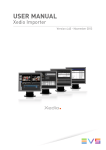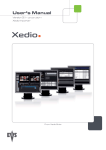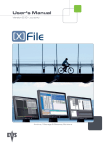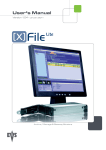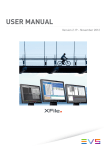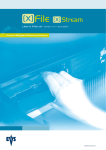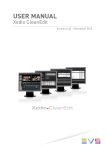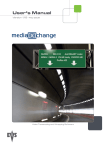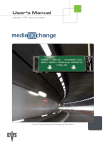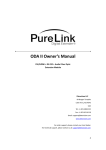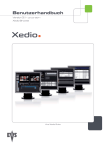Download Xedio Importer User Manual
Transcript
USER MANUAL Xedio Importer Version 4.50 - August 2014 USER MANUAL Xedio Suite 4.50 Xedio Importer Copyright EVS Broadcast Equipment SA– Copyright © 2010-2014. All rights reserved. Disclaimer The information in this manual is furnished for informational use only and subject to change without notice. While every effort has been made to ensure that the information contained in this user manual is accurate, up-to-date and reliable, EVS Broadcast Equipment cannot be held responsible for inaccuracies or errors that may appear in this publication. Improvement Requests Your comments will help us improve the quality of the user documentation. Do not hesitate to send improvement requests, or report any error or inaccuracy on this user manual by e-mail to [email protected]. Regional Contacts The address and phone number of the EVS headquarters are usually mentioned in the Help > About menu in the user interface. You will find the full list of addresses and phone numbers of local offices either at the end of this user manual (for manuals on hardware products) or at the following page on the EVS website: http://www.evs.com/contacts. User Manuals on EVS Website The latest version of the user manual, if any, and other user manuals on EVS products can be found on the EVS download center, on the following webpage: http://www.evs.com/downloadcenter. I USER MANUAL Xedio Suite 4.50 Xedio Importer Table of Contents TABLE OF CONTENTS III WHAT'S NEW? V 1. 1 INTRODUCTION 1.1. Purpose 1 1.2. Opening Xedio Importer 2 1.3. Importable Media 3 1.4. General Import Process and Mandatory Fields 3 2. 4 IMPORTING XDCAM, XDCAMEX, P2 AND CANON FILES 2.1. Introduction 4 2.2. Import Process 5 2.3. Fields in the XDCAM, XDCAMEX, P2 and CANON Tabs 5 2.4. Setup Window 6 2.4.1. Opening of the Setup Window 6 2.4.2. File Tab 7 2.4.3. Selection Tab 9 2.4.4. Audio Channel Assignment Tab 3. 16 3.1. Introduction 16 3.2. Single File or Batch Import 16 3.3. Setup 18 3.4. Fields in the Video/Audio/Stills Tab 19 4. Table of Contents IMPORTING VIDEO / AUDIO / STILLS FILES 11 IMPORTING TRANSITION EFFECTS (RTD) 21 4.1. Introduction 21 4.2. Background Information on TIFFs and RTDs 21 4.2.1. Tiff Files Required for an RTD 21 4.2.2. Requirements for TIFF Files 22 4.3. Setup 22 4.4. Fields in the RTD tab 23 III USER MANUAL Xedio Suite 4.50 Xedio Importer What's New? In the user manual, the icon has been added on the left margin to highlight information on new and updated features. The sections updated to reflect the new and modified features on Xedio Importer from Xedio Suite 4.50 (compared to Xedio Suite 4.40) are listed below. LinX, and the direct access to EVS serves, is no more supported It is no more possible to import media files available on an EVS video server to the Xedio suite. The EVS Server tab is no more available. • What's New? See section "Importable Media" on page 3. V USER MANUAL Xedio Suite 4.50 Xedio Importer 1. Introduction 1.1. Purpose In Xedio, the Media Importer tool offers a way of acquiring media files for use within the system. Authorized users may import, into the Xedio database, media that have already been recorded and are in a file format that can be used by Xedio. P2, XDCAM and XDCAM EX, music, graphics or existing mpeg and dv files are some examples. Once the files are imported and set to "Publish", they become available in the Media Manager. The Media Importer tool is available as: 1. Introduction • a separate application: Xedio Importer • a module built in CleanEdit, and available in the Media Importer tab. • a module built in Xedio Manager, and available in the Media category. 1 EVS Broadcast Equipment SA Issue 4.50.A - August 2014 Note The color of some user interface elements may vary with the Xedio skin installed. 1.2. Opening Xedio Importer To start the Xedio Importer application, select the application from Start > Programs > EVS Broadcast Equipment or click on the Xedio Importer shortcut icon on the desktop. The Xedio workstation may be integrated into an Active Directory domain. In this case, Xedio Importer will automatically open without requesting additional access codes when the user starts it. 2 1. Introduction USER MANUAL Xedio Suite 4.50 Xedio Importer The user group the user belongs to in the Windows domain must be linked to a user role in Xedio Manager. This determines the set of user rights and user settings the user will have in the application. In case a user belongs to several Windows groups, the system retrieve them in alphabetical order and checks whether the first group matches a user role. The use of Windows authentication must have been enabled in Xedio Manager. See the Xedio Manager user manual for more information. In case the auto-log off mode is activated and the Windows authentication by Active Directory mode is used, the auto-log off becomes an auto-quit function. If the Xedio workstation is not integrated into an Active Directory domain, a login screen will display, where users have to enter their own Xedio username and password. 1.3. Importable Media The Xedio Importer main window allows you to select media to import. Different tabs can be displayed, provided that they have been selected from Xedio Manager: Softwares > Parameter Profiles. They are used to set the parameters for the different types of media which can be imported into the system: 1.4. • XDCAM, XDCAMEX, P2 and CANON tabs: to import media files recorded on Sony XDCAM and XDCAMEX, Panasonic P2 and CANON cameras • Video/Audio/Stills tab: to import media files, images or audio files • RTD tab: to import video containing transitions General Import Process and Mandatory Fields The import process is similar in all tabs. However, the file-related information you can provide depends on the file to import. The mandatory field names are displayed in red in the user interface as long as you do not define a value for them. Warning messages are also displayed at the bottom of the tab to tell the user which fields should be filled in. In each tab and for all import sessions, the mandatory steps and information are the following: 1. Specify where Xedio Importer will find the source files to be imported. 2. Specify the Label field, that is to say the name of the media when it will be imported into Xedio CleanEdit. 3. Tick the Published check box to make the media available and visible to all users. 4. Click the Start Import Process button at the bottom of the window. Once imported, the files will be available in CleanEdit, in the Media Manager tab. 1. Introduction 3 EVS Broadcast Equipment SA Issue 4.50.A - August 2014 2. Importing XDCAM, XDCAMEX, P2 and CANON Files 2.1. Introduction The XDCAM, XDCAMEX, P2 and CANON tabs allow importing media files created with a XDCAM, XDCAMEX, P2 or CANON camera. The source files can be retrieved from a camera directly connected to the CleanEdit workstation or are made available via an FTP server. 4 2. Importing XDCAM, XDCAMEX, P2 and CANON Files USER MANUAL Xedio Suite 4.50 Xedio Importer 2.2. Import Process To be able to import files from XDCAM, XDCAMEX, P2 and CANON cameras, you need to proceed as follows: 1. In the Setup window you can access by clicking the Setup button, define: ◦ the source and destination locations, ◦ the default values for the properties of the imported files, ◦ the audio channel assignment. 2. Specify the Label field, that is to say the name of the media when it will be imported into Xedio CleanEdit. 3. If requested, change the file properties before you perform a given import. 4. Ensure that the Published check box is ticked to make the media available and visible to all users. 5. Select the files you want to import from the Media List: ◦ Press CTRL + click on the files for a selection of multiple non-contiguous files. ◦ Press SHIFT + click on the first and last file for a selection of multiple contiguous files. 6. Click the Start Import Process button at the bottom of window. At the end of the import process, a message specifies how many files have been successfully imported. Once imported, the files are available in CleanEdit, in the Media Manager tab. 2.3. Fields in the XDCAM, XDCAMEX, P2 and CANON Tabs General Properties Field Description Auto Src Disk List of disks detected when the source files are searched on disks using the Auto Src Disk process (selected in the Setup). Aspect Ratio Check box to select how the aspect ratio of the imported files will be chosen. Possible values: • 4/3: all the files with 4/3 aspect ratio are automatically imported. • 16/9: all the files with 16/9 aspect ratio are automatically imported • 4/3 and 16/9: all the 4/3 files and the 16/9 files are automatically imported. • "No aspect ratio selected": you need to manually select the files to import in the Media List. 2. Importing XDCAM, XDCAMEX, P2 and CANON Files 5 EVS Broadcast Equipment SA Issue 4.50.A - August 2014 Field Description Refresh Button to force the data to be refreshed when the setup parameters have been changed. Setup Button to access the setup parameters. Media Properties Field Description Label (mandatory) Name assigned to the files when they are imported to the Xedio database. Shooting date (mandatory) Date when the media was recorded by the camera. Default: current date Media Class (mandatory) Class categorizing the media as defined in Class Manager in Xedio Manager. Default: Undefined Publish Check box that allows you to see the imported media in the client workstations database lists. You need to check it if you want to use the media in CleanEdit. External Ref. External reference of the source support, for example a barcode identifying a tape of a VTR. Description Optional text to describe the media. Media List This list automatically filled in with the detected source files that can be imported from the source location. Select the media to import from the list and click the Start Import Process button to import the files to the specified destination. 2.4. Setup Window 2.4.1. Opening of the Setup Window Clicking the Setup button on the top right corner of the XDCAM, XDCAMEX, P2 or CANON tab opens the Setup window. 6 2. Importing XDCAM, XDCAMEX, P2 and CANON Files USER MANUAL Xedio Suite 4.50 Xedio Importer 2.4.2. File Tab Overview The information in this tab makes it possible to specify where and how the source file will be identified, and where the files will be imported to. Field Description Tools Enable Merger This option is only available with XDCAM files. Select this option to enable the merger engine. • Enable Merger with hi-res audio extraction: Third-party engine that concatenates all source clips selected for import into a single media and that replaces the audio from the lo-res media by the audio from the hi-res media to improve the lo-res audio quality. • Allow one-by-one import: allows the import of clips one by one (file transfer mode) in case the merge cannot be done (clips of different types, codec or aspect ratio detected in the selection) 2. Importing XDCAM, XDCAMEX, P2 and CANON Files 7 EVS Broadcast Equipment SA Issue 4.50.A - August 2014 Field Description Generate Import List Select this option to generate an XML file with the list of clips at the end of the import process. Use the Browse button to select the destination folder to store the XML files. Generate missing proxy Select this option to generate the proxy when it is missing on the device during hi-res media import. Source Select the option to be used to detect the source files: Auto Src Disk Option to automatically scan the camera disks for new files to be imported. Drive/path Drive or path to access a camera or device connected to the Xedio workstation via a USB or FireWire connection (depending on the device). FTP FTP server used with some cameras or devices that are connected to the Xedio workstation via a GigE connection. The IP address, the login and password to connect to the FTP server need to be specified. Destination Hi-res server Media server that will be used to store the imported files. The list is retrieved from the media servers where a hi-res folder is defined in Xedio Manager (Media > Servers tool). FTP FTP server where the imported hi-res files will be stored. The IP address, the login and password to connect to the FTP server need to be specified. Lo-res server Media server that will be used to store the imported files. The list is retrieved from the media servers where a lo-res folder is defined in Xedio Manager (Media > Servers tool). FTP FTP server where the imported lo-res files will be stored. The IP address, the login and password to connect to the FTP server need to be specified. Subfolder Subfolder where the files will be stored on the Media server. The subfolders are created automatically during the import process. It is based on metadata fields selected from a list. How to Define the Storage Subfolder To define the subfolder where the files will be stored, proceed as follows: 1. Click the button next to Subfolder. The Folder Auto Name window opens. 2. Select one of the options from the list of available items. 3. Click Append to add the selected item at the end of the folder string. 4. Repeat steps 2 and 3 for any new information type you want to add in the string. 5. Click OK. The selected string is displayed in the File tab. 8 2. Importing XDCAM, XDCAMEX, P2 and CANON Files USER MANUAL Xedio Suite 4.50 Xedio Importer 2.4.3. Selection Tab Overview The Selection tab makes it possible to identify default values, which can then be modified in the main tab. Field Description Mode Three options are available to set the clip type to be used in the clip list: • All Clips • Clips with proxy • Clips without proxy Properties Specifies the default values for some fields of the main XDCAM, XDCAMEX, P2 or CANON tab. Media Class Default media class selected in the XDCAM, XDCAMEX, P2 or CANON tab. 2. Importing XDCAM, XDCAMEX, P2 and CANON Files 9 EVS Broadcast Equipment SA Issue 4.50.A - August 2014 Field Description Publish When this option is selected, imported media is visible in the Media lists. When this option is not selected, imported media is only visible in Xedio Manager. • Without merge option: the visible media are all the clips. • With merge option, the visible media is the merged file. Create CleanEdit Project When the check box is ticked, a CleanEdit project will automatically be created for the logged user each time an import process is started. In case of automatic import, the CleanEdit project is created for all the media imported automatically. At the end of the import without merge, the Media bin of the new project is filled with all the clips transferred. At the end of the import with merge, the Media bin of the new project is filled with the merged file transferred and the Clips bin is filled with clips corresponding to the clips on the device. Project Name Extension Extension that will be used to name the project when it is automatically created. The project name will be the concatenation of the label and the project extension. Imported Filename Format String String used as a template to assign a name to the imported media files. It is based on metadata fields selected from a list. Generated String used as a template to assign a name to the clips generated in the Clipnames database when importing a selection of files. It is based on metadata fields selected from a list. Format String How to Define the Filename or Clipname format string To define the filename format string or the clipname format string, proceed as follows: 1. Click the button. The Media AutoName window opens. 2. Select one of the options from the list of available items. 3. Click Append to add the selected item at the end of the name string. 4. Repeat steps 2 and 3 for any new information type you want to add in the name string. 10 2. Importing XDCAM, XDCAMEX, P2 and CANON Files USER MANUAL Xedio Suite 4.50 Xedio Importer 2.4.4. Audio Channel Assignment Tab Purpose The Audio Channel Assignment tab makes it possible to specify how the audio stereo channels of the source file will be assigned in the CleanEdit audio configuration. Note Once the audio track assignment has been defined in Xedio Importer or AutoFile Importer, these values will always be used on the workstation instead of the default ones defined in Xedio Manager. 2. Importing XDCAM, XDCAMEX, P2 and CANON Files 11 EVS Broadcast Equipment SA Issue 4.50.A - August 2014 How to Define Audio Channel Assignment It is possible to define the audio channel assignment to be taken into account for the selected type of media file, XDCAMEX in this example. To do so, proceed as follows. 1. From the Physical Channels list, select the required number of channels. As many blocks as audio channels selected are displayed in the window. 2. Right-click an audio channel field. The following contextual menu appears: 3. Select one of the options: 12 ◦ Mono: one audio channel is used. ◦ Stereo: two audio channels are used 2. Importing XDCAM, XDCAMEX, P2 and CANON Files USER MANUAL Xedio Suite 4.50 Xedio Importer ◦ 5.1: six audio channels are used 4. Repeat the 2 last steps for the remaining channels. How to Change the Order of Channels inside a Track If required, you can re-assign the order of the channels inside a group. To do so, proceed as follows: 1. Right-click an audio channel box. One of the following contextual menus appears: ◦ Mono: In this case, there is no other choice. 2. Importing XDCAM, XDCAMEX, P2 and CANON Files 13 EVS Broadcast Equipment SA ◦ Stereo: ◦ 5.1: Issue 4.50.A - August 2014 2. Select one of the options. Consequently, two channels will have the same name within a group. So the group name is displayed in red. You will not be able to save the changes until this is solved. How to Remove a Track Assignment To cancel the assignment of a track, proceed as follows: 1. Right-click the audio track block. A contextual menu is displayed. 2. Select Remove Group. The corresponding blocks are empty and available again. 14 2. Importing XDCAM, XDCAMEX, P2 and CANON Files USER MANUAL Xedio Suite 4.50 Xedio Importer How to Change the Order of Tracks Assignment If required, you can modify order of the channels between them. To do so, proceed as follows: 1. Right-click an audio track block. A contextual menu is displayed. 2. Select Move Group Down to move the track after the next one, or Move Group Up to move the track before the previous one. 2. Importing XDCAM, XDCAMEX, P2 and CANON Files 15 EVS Broadcast Equipment SA Issue 4.50.A - August 2014 3. Importing Video / Audio / Stills Files 3.1. Introduction To import new video in an architecture working with high resolution and low resolution files, the two corresponding files must be imported at the same time from the Video/Audio/Stills tab. The high resolution file will be used for high resolution workstations and the low resolution files will be used on the lo-resolution workstations. The import process will reference this new media in the database based on common timecode range in both files. The imported low resolution files must be compatible with the high resolution files. If they are incompatible, an error message will be generated. During a batch import, incompatible files are not imported. The following compatibility table lists the high resolution video standards and the corresponding low resolution proxies 3.2. High resolution video standard Low resolution proxy video frequency HD1080i @50 @25 or 50 HD1080i @59.94 @29.97 or 59.94 HD720p @50 @25 or 50 HD720p @59.94 @27.97 or 59.94 PAL SD @25 NTSC SD @29,97 Single File or Batch Import Introduction There are two ways to import media inside the system: • The first one is a single file import that allows you to specify a label for the item. • The second one, the “batch import”, allows you to import the content of entire folders but uses the original file names as the name for the media (label). In both cases, you can apply the general import process defined in section "General Import Process and Mandatory Fields" on page 3 to import the requested files. 16 3. Importing Video / Audio / Stills Files USER MANUAL Xedio Suite 4.50 Xedio Importer Single File Import 3. Importing Video / Audio / Stills Files 17 EVS Broadcast Equipment SA Issue 4.50.A - August 2014 Batch Import 3.3. Setup Before you start importing files, you need to specify the following parameters via the Setup button: 18 • The media server where the lo-res and hi-res files will be stored when they are imported. • How the audio tracks in the source file will be assigned in the CleanEdit audio configuration. Up to 16 audio channels can be assigned. 3. Importing Video / Audio / Stills Files USER MANUAL Xedio Suite 4.50 Xedio Importer 3.4. Fields in the Video/Audio/Stills Tab The following table describes the common fields that will be used when you perform a single file import or batch import: Field Description Properties sub-tab Shooting date (mandatory) Date when the media was recorded by the camera. Default: current date Media Class (mandatory) Class categorizing the media as defined in Class Manager in Xedio Manager. Default: Undefined Publish Check box that allows you to see the imported media in the client workstations database lists. External Ref. External reference of the source support, for example a barcode identifying a tape of a VTR. Description Optional text to describe the media. Sub-folder Sub-folder to use (or create) on the storage server. Setup Button to access the parameters for the imported files. Metadata sub-tab The metadata fields from the default metadata profile for media are displayed and can be filled in with the requested values. The following table describes the fields specific to the single file import: Field Description Label (mandatory) Name assigned to the files when they are imported to the Xedio database. Low Bitrate fields The Browse button allows the selection of the lo-res file. High Bitrate fields The Browse button allows the selection of the corresponding hi-res file. Note Both hi-res and lo-res files need to have a common range of timecode to be imported as a new media in the system. 3. Importing Video / Audio / Stills Files 19 EVS Broadcast Equipment SA Issue 4.50.A - August 2014 The following table describes the fields specific to the batch import. They allow the definition of settings related to the source files: 20 Field Description LowRes folder Folder where the source lo-res files are stored. HiRes folder Folder where the source hi-res files are stored. Scan Filter File format extension of the files to be imported. When the file extension is specified in this field, the application will scan for and import the files having this extension. It is recommended to use the scan filter in case of multi-file formats. For example, the scan filter will be *.mxf for OPAtom, and *.mov for QuickTime Ref. Video Ratio Video ratio of the source files, that is to say 4/3 or 16/9. 3. Importing Video / Audio / Stills Files USER MANUAL Xedio Suite 4.50 Xedio Importer 4. Importing Transition Effects (RTD) 4.1. Introduction An RTD is a transition effect that can be used in Xedio CleanEdit between two video clips. RTDs are sequences of numbered files in TIFF format, designed with two keys. This tab makes it possible to convert a sequence of TIFF pictures into a transition effect file for CleanEdit. It is recommended to create RTDs not exceeding 1.5 seconds. Warning Inside an edit, the total duration of all different RTDs used in a timeline CANNOT exceed 4 seconds! Note that the same RTD can be used as many times as you need inside a timeline as soon as the total duration constraint is met. 4.2. Background Information on TIFFs and RTDs 4.2.1. Tiff Files Required for an RTD Logo or stills with a key are supported under the TIFF and TGA file formats: 4. Importing Transition Effects (RTD) 21 EVS Broadcast Equipment SA Issue 4.50.A - August 2014 The Tiff files consist of three elements: • the visible bitmap • the bitmap key In the bitmap key, white represents an area of the picture which will remain visible and black represents an area of the picture which will be transparent. • the transition key In the transition key, white represents the current picture and black represents the next picture. This is represented in the picture below: 4.2.2. Requirements for TIFF Files You need to have an even number of Tiff files for your RTD sequence. The Tiff files used in an RTD sequence should be full size: • in SD PAL: 720 x 576 pixels • in SD NTSC: 720 x 480 pixels • in HD: 1920 x 1080 pixels In PAL, the 768 pixel resolution is reduced to 720 in 4:3, and the 1024 pixel resolution to 720 in 16:9 to keep the aspect ratio. The Tiff files should be done in RGB mode, 24 bits/pixels (8 bits/color), 2 keys. 4.3. Setup Before you start importing files, you need to specify, via the Setup button, the media server where the lo-res and hi-res files will be stored when they are imported. 22 4. Importing Transition Effects (RTD) USER MANUAL Xedio Suite 4.50 Xedio Importer 4.4. Fields in the RTD tab To preview and import a RTD (Replay Transition Device) sequence, select the RTD tab, complete the following fields, then click on the Start Import Process button to copy the effect file on the storage server and add the effect in the database. The following table describes the fields. Field Description Label Name assigned to the files when they are imported to the Xedio database. (mandatory) First File The Browse button allows the selection of one file from the sequence to be imported. Files found Number of files found in the same folder as the selected first file. You need to have an even number of .tiff files to import for your RTD sequence. 4. Importing Transition Effects (RTD) 23 EVS Broadcast Equipment SA 24 Issue 4.50.A - August 2014 Field Description Video Standard Video standard to apply to create the transition: PAL SD, HD 1080i @50, HD 720p @50, HD 1080p @50, NTSC drop SD, HD 1080i @59,94, HD 720p @59,94, HD 1080p @59.94 Preview Button Displays the corresponding pictures in the Bitmap, Bitmap Key and Transition Key fields and then converts the sequence to display it in the Result field. 4. Importing Transition Effects (RTD) Corporate +32 4 361 7000 North & Latin America +1 973 575 7811 EVS Headquarters Liège Science Park 16, rue Bois St Jean B-4102 Seraing Belgium To learn more about EVS go to www.evs.com Asia & Pacific +852 2914 2501 Other regional offices www.evs.com/contact EVS Broadcast Equipment is continuously adapting and improving its products in accordance with the ever changing requirements of the Broadcast Industry. The data contained herein is therefore subject to change without prior notice. Companies and product names are trademarks or registered trademarks of their respective companies.


































